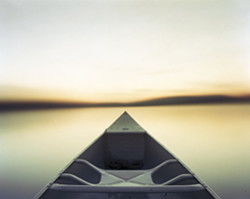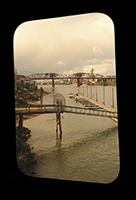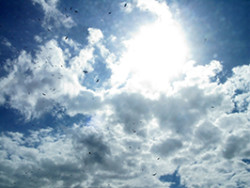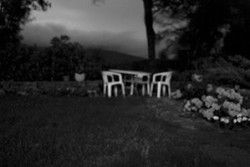Tony Hungerford Memorial Gallery @ College of Southern Maryland, La Plata, MD
November 16 – December 14, 2015
view installation photos »
Travel is no stranger to the history of photography in America. From early photographs capturing the expanse of The West to Robert Frank’s two-year road trip across the country and to even more recent work of Alec Soth’s scavenger hunt journeys, again and again photographers utilize the camera to capture their travel. But what happens when we focus less on the destinations and more on the actual act of journeying? How can photographers use the camera as a means of showing movement through landscape?
drift brings together the work of four photographers, Caleb Charland, Candace Gaudiani, E. Brady Robinson, and Alexandra Silverthorne, to explore these questions. While each photographer tackles the journey through landscape with different constraints and styles, we are ultimately presented with a unified series that prompts us to consider our own movement whether through landscape or even activities of daily life.

The way we understand the world relies so much on our ability to measure it. Given that many measurements are based on the proportions of the human body, it’s clear we measure stuff to find our place in it and to connect with it in some way. By exploring the world at hand, from the basement to the backyard, Charland has found a resonance in things. An energy vibrates in that space between our perceptions of the world and the potential the mind senses for our interventions within the world. This energy, the source of all true art and science, breeds those beloved “Ah Ha!” moments allowing us to sense the extraordinary in the common.
In Charland’s work, each piece begins as a question of visual possibilities and develops in tandem with the natural laws of the world. This process often yields unexpected results measurable only through photographic processes.

Forty Eight States emerged over seven years of travel through the United States by train, car, and plane in addition to decades of travel through all forty eight states. For this series, Gaudiani retraced old routes and memories from the Fifties reflecting on endless possibilities, missed opportunities, fleeting intimacies, and other reflections on a life. The road trip – an iconic rite for many Americans – is her defining passion. These photographs capture a timeless America: one that is no longer there as it was in the Fifties, yet remains through the linkage of knowledge, memory, and photographs. Her images are both specific and conceptual. The landscape is vertical and framed contrasting the traditional sweeping horizontal mode. Photographs evoke a dreamy, romantic yearning for the land and what it means to be an American in the landscape, sometimes part of, and sometimes estranged from the places we hold in our memories.

Robinson’s work is informed by a culture of instant and mobile image capture. She uses the camera to examine her environment and record fleeting moments of existence. The series Transfer is based on the concept of the drift – Drifting draws upon pure chance and opportunity for new and authentic experiences generated by different atmospheres from urban landscapes and new places. The snapshot aesthetic is utilized as means to quickly record, document, and observe. She combines mobile image capture with the concept of the pyschogeographic drift. Coined by French theorist Guy Debord, pyschogeography is “the study of precise laws and specific effects of geographic environments, consciously organized or not, on the emotions and behavior of individuals.” Transfer is a mapping of geography encountered both at home and abroad as well as a deliberate re-contextualization of sequential shots to describe a territory where the social/cultural landscape, personal experience, and pure aesthetics meet.
Represented by Addison Ripley Fine Art and Amstel Gallery

Alexandra Silverthorne | Washington, DC
In the MidNights series, Silverthorne uses lectures from 1906 as a starting point to explore movement through landscape. Titled The Integrative Action of the Nervous System, English neurophysiologist Charles Scott Sherrington introduces the study of proprioception. Proprioception is concerned with the ways a body moves through a space in relation to itself. Looking beyond the 5 senses, proprioception explores the innate and instinctive knowledge that the body has of its own movements. In applying the theory towards a larger understanding of extended space, we can ask how humans move through something as complex as a landscape? And how might we hybridize our senses to understand a landscape that is unfamiliar to us? With a self-imposed limit of five minutes, during each trip away from home, Silverthorne set out to discover the land. Each photograph is identified only by the date that it was taken. Location details are never provided.
curated by Alexandra Silverthorne